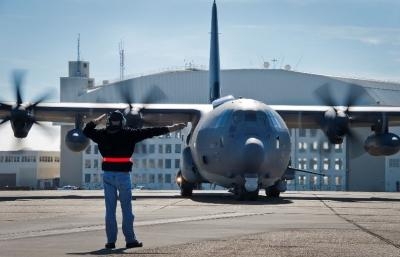Wed, Feb 12, 2014
Called A 'Best Of Both Worlds' Aircraft By The Air Force
After more than a year of modification maintenance, the newly created AC-130J Ghostrider took to the sky for the first time as a gunship at Eglin AFB in Florida Jan. 31.

In early January 2013, the Air Force Special Operations Command MC-130J Commando II arrived here to begin the modification process with the goal of creating a "best of both worlds" aircraft. The end result became a hybrid C-130 model with the flying proficiencies of the MC-130J and the combat capabilities of an AC-130. The modification was completed at Eglin because the AC-130J test team and test program are located there.
"After the modification was completed, the aircraft could remain here where we could take it out for the first flight,” said Maj. Brian Taliaferro, the aircraft commander for the flight. “That's why Eglin (AFB) was the best choice."
Converting a mobility aircraft into a strike aircraft meant adding some hardware. That came in the form of the Precision Strike Package, which was developed by U.S. Special Operations Command to support ground forces in overseas contingency operations. "These new weapon systems and small diameter bombs provide over watch and further standoff distance to cover a wider range of space for our warfighters on the ground," said Maj. Eric Ripple, the USSOCOM Detachment 1 commander.
The Precision Strike Package includes dual electro-optical infrared sensors, a 30-mm cannon, AGM-176A Griffin missiles, all-weather synthetic aperture radar and GBU-39 small diameter bomb capabilities. The sensors allow the gunship to visually or electronically identify friendly ground forces and targets at any time, even in adverse weather.
Pairing weapons with a networked battle management system, enhanced communications and situational awareness upgrades the AC-130J’s ability to deliver surgical firepower. "We get the successes of the Precision Strike Package and marry it up with the advantages of the J-model bringing the best two C-130s together in a new weapons system," said Todd McGinnis, the USSOCOM AC-130J modification manager at Det. 1.
The aircrew from Eglin's AFB 413th Flight Test Squadron took the new aircraft out for its first official sortie. The squadron is the lead participating test organization for the developmental testing of the AC-130J. "As with any new or highly modified aircraft, the initial goal is to ensure the aircraft design or modification does not adversely affect the flying and handling qualities," Taliaferro said. "We have dedicated six flights at the beginning of the test program to accomplish this task."
According to Taliaferro, to be involved with a first flight is rare in the test pilot community, but they are trained to accomplish a mission like this. “It's rewarding when the training leads to a successful, smooth flight like this one," he said. "The flight went excellent. We met our primary objective, which was to clear the envelope sufficiently to allow for a safe landing."
To do this, after takeoff, the aircrew left the landing gear and flaps down until reaching a safe altitude. They incrementally slowed the aircraft to touchdown speed, checking the flying and handling qualities at each speed. The 413th FLTS crew also completed multiple swings of the landing gear to ensure it had proper clearance with the new modifications. They also performed flying and handling quality assurance tests during the three and a half hour flight. "This is a big accomplishment not just for the AC-130J test team and the 413th FLTS, but also for the 96th Test Wing, who provided many pivotal support functions to make this flight a success," Taliaferro said.
A total of 32 MC-130J aircraft will be modified for AFSOC as part of a $2.4 billion AC-130J program to grow the future fleet, according to Capt. Greg Sullivan, the USSOCOM AC-130J on-site program manager at Det. 1.
(USAF Photo)
More News
The Industry Continues to be Rocked By Some Questionable Operations Recent investigations and a great deal of data has resulted in ANN’s SportPlane Resource Guide’s rep>[...]
Make Sure You NEVER Miss A New Story From Aero-News Network Do you ever feel like you never see posts from a certain person or page on Facebook or Instagram? Here’s how you c>[...]
Visual Approach Slope Indicator (VASI) An airport lighting facility providing vertical visual approach slope guidance to aircraft during approach to landing by radiating a directio>[...]
Airport Marking Aids Markings used on runway and taxiway surfaces to identify a specific runway, a runway threshold, a centerline, a hold line, etc. A runway should be marked in ac>[...]
Aero Linx: The Skyhawk Association The Skyhawk Association is a non-profit organization founded by former Skyhawk Pilots which is open to anyone with an affinity for the A-4 Skyhaw>[...]
 Unfortunate... ANN/SportPlane Resource Guide Adds To Cautionary Advisories
Unfortunate... ANN/SportPlane Resource Guide Adds To Cautionary Advisories ANN FAQ: Turn On Post Notifications
ANN FAQ: Turn On Post Notifications ANN's Daily Aero-Term (04.29.24): Visual Approach Slope Indicator (VASI)
ANN's Daily Aero-Term (04.29.24): Visual Approach Slope Indicator (VASI) ANN's Daily Aero-Term (04.28.24): Airport Marking Aids
ANN's Daily Aero-Term (04.28.24): Airport Marking Aids ANN's Daily Aero-Linx (04.28.24)
ANN's Daily Aero-Linx (04.28.24)



